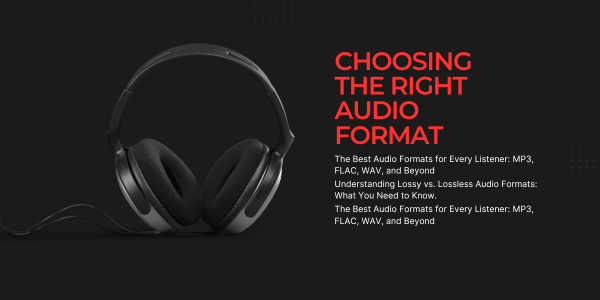Understanding Audio Formats: MP3, FLAC, WAV, AAC, and More.
Regarding audio, many file formats are available, each with its own strengths and weaknesses. Whether you’re a casual listener, an audiophile, or a content creator, understanding these formats can help you choose your listening experience or production needs. This article will explore the differences between common audio formats like MP3, FLAC, WAV, WMA, AAC, and others, including both lossy and lossless compression methods, as well as uncompressed formats.
1. MP3 (MPEG-1 Audio Layer 3)
MP3 is one of the most popular audio file formats. It uses lossy compression, meaning some of the audio data is discarded to reduce the file size. MP3 strikes a balance between file size and sound quality, making it ideal for portable music players and streaming services.
- Compression: Lossy
- File Size: Small (depends on bit rate, typically ranging from 128kbps to 320kbps)
- Use Case: Portable music, streaming, podcasts
MP3’s efficiency in compression makes it a common format for general listening, though audiophiles might prefer higher-quality, lossless formats for critical listening.
2. FLAC (Free Lossless Audio Codec)
FLAC is a lossless compression format, meaning it compresses audio without losing any of the original quality. Unlike MP3, FLAC retains all the detail in the original audio, making it popular among audiophiles and for archiving high-quality music collections.
- Compression: Lossless
- File Size: Larger than MP3 but smaller than WAV (typically 30-60% of the original file size)
- Use Case: Audiophile music libraries, archiving, high-quality streaming
Because it is lossless, FLAC is a favorite for those who demand the best sound quality.
3. WAV (Waveform Audio File Format)
WAV is an uncompressed audio format that represents sound as raw data. It offers the highest sound quality because no data is lost in the process. WAV files are commonly used in professional settings like recording studios and audio production.
- Compression: Uncompressed
- File Size: Large (roughly 10MB per minute of stereo audio at CD quality)
- Use Case: Professional recording, sound design, high-quality audio storage
Though WAV files are uncompressed and very large, their use in professional environments ensures the highest fidelity.
4. WMA (Windows Media Audio)
WMA is a proprietary audio format developed by Microsoft. It comes in both lossy and lossless versions. The lossy version (WMA Standard) offers file sizes similar to MP3 with decent quality, while WMA Lossless provides compression without quality loss, though it’s not as widely supported as other lossless formats like FLAC.
- Compression: Lossy (Standard) or Lossless (WMA Lossless)
- File Size: Similar to MP3 for lossy, smaller for lossless than WAV
- Use Case: Windows-based environments, Microsoft services
WMA is mostly used for streaming or playing on Windows-based devices, but its lossless version is less popular outside the Microsoft ecosystem.
5. OGG Vorbis
OGG Vorbis is an open-source, lossy audio compression format often compared to MP3, but with better sound quality at similar bit rates. It is commonly used in gaming and streaming services that support open formats.
- Compression: Lossy
- File Size: Similar to MP3
- Use Case: Gaming, open-source applications, streaming
OGG is a good alternative to MP3 and is used for high-quality streaming where licensing fees (like those for MP3) are a concern.
6. PCM (Pulse Code Modulation)
PCM is the standard method used to digitally represent analog audio signals. It is uncompressed and typically used in professional audio production. WAV files, for example, are often stored in PCM format.
- Compression: Uncompressed
- File Size: Very large
- Use Case: Audio recording, professional editing, CD-quality audio
PCM is the gold standard in digital audio because it offers the most accurate representation of the original analog signal.
7. MP4 (MPEG-4 Part 14)
MP4 is a multimedia container format that can hold both audio and video data. While it is most often associated with video, MP4 can store AAC audio, which is compressed but still offers good sound quality at a smaller file size.
- Compression: Typically uses AAC (Lossy)
- File Size: Moderate
- Use Case: Video and audio playback, streaming
MP4 is widely used for multimedia files, often used in online video streaming, and has good audio compression with AAC.
8. Opus
Opus is a highly versatile audio codec that provides excellent audio quality at a low bit rate. It is primarily used in real-time communications, such as VoIP calls, streaming, and video conferencing.
- Compression: Lossy
- File Size: Very small with high quality at low bit rates
- Use Case: Streaming, VoIP, real-time communications
Opus is considered one of the best codecs for speech and general audio at low bit rates, offering superior quality for real-time applications.
9. DSD (Direct Stream Digital)
DSD is a high-resolution audio format used primarily in SACD (Super Audio CDs) and for audiophile recordings. Unlike PCM, DSD stores audio data in a one-bit format with a much higher sampling rate, which provides a very natural sound reproduction.
- Compression: Uncompressed (with variations for storage)
- File Size: Very large
- Use Case: Audiophile recordings, high-resolution audio playback
DSD is used by audiophiles who seek the highest quality, and while it’s not as widely adopted, it remains a hallmark of premium audio.
10. AAC (Advanced Audio Codec)
AAC is a lossy audio codec designed to be more efficient than MP3, delivering better sound quality at the same bit rates. It’s commonly used in streaming platforms like YouTube, Apple Music, and podcasts.
- Compression: Lossy
- File Size: Similar to MP3 but higher quality at the same bit rate
- Use Case: Streaming, digital music services
AAC is the preferred format for many streaming platforms due to its efficient compression and quality.
11. Apple Lossless Audio (ALAC)
ALAC is Apple’s lossless audio codec, offering compression without any loss of quality. It’s used for music playback in Apple’s ecosystem, including on iTunes and Apple Music.
- Compression: Lossless
- File Size: Smaller than uncompressed formats like WAV
- Use Case: Apple ecosystem (iTunes, Apple Music, Apple devices)
For Apple users who want high-quality audio without sacrificing storage space, ALAC is a great choice.
Lossy vs. Uncompressed vs. Lossless Formats
- Lossy Compression: Formats like MP3, OGG, and AAC use lossy compression, which reduces file sizes by discarding some audio data. While this results in smaller files, it can affect audio quality, especially at lower bit rates.
- Lossless Compression: Formats like FLAC and ALAC preserve the original audio data without loss. While the files are larger than lossy formats, the sound quality remains intact.
- Uncompressed: PCM and WAV are uncompressed formats, storing audio in its rawest form. They offer the best sound quality but come with the largest file sizes, making them ideal for professional applications but impractical for everyday listening.
Conclusion
The choice of audio format largely depends on your needs. If you’re looking for convenience and portability, lossy formats like MP3, AAC, or OGG are ideal. For audiophiles and those seeking the best sound quality, lossless formats like FLAC, ALAC, and DSD offer the clearest, most accurate playback. Professionals might prefer uncompressed formats like WAV and PCM for maximum fidelity in production environments. Understanding these formats will help you navigate the vast world of digital audio and choose the best option for your situation.
/pf/
This article was rewritten by JournosNews.com based on verified reporting from trusted sources. The content has been independently reviewed, fact-checked, and edited for accuracy, neutrality, tone, and global readability in accordance with Google News and AdSense standards.
All opinions, quotes, or statements from contributors, experts, or sourced organizations do not necessarily reflect the views of JournosNews.com. JournosNews.com maintains full editorial independence from any external funders, sponsors, or organizations.
Stay informed with JournosNews.com — your trusted source for verified global reporting and in-depth analysis. Follow us on Google News, BlueSky, and X for real-time updates.













